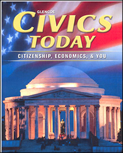
Civics Today Citizenship, Economics, & YouChapter 9: Political Parties and PoliticsChapter OverviewsGeorge Washington disliked political parties and hoped that they would not develop in the United States. Almost immediately, however, two members of his cabinet developed major differences and established what have become our two major political parties. A political party is an association of voters who usually share beliefs about politics and want to influence or control decision making in government. They hope to accomplish this by electing the party's candidates to public office. Throughout our nation's history there have been two major parties. However, third parties have occasionally arisen and influenced politics. It can sometimes be difficult to tell the difference between the Republican and Democratic Parties. The basic difference is each party's belief in how much the government should be involved in the lives of Americans. Each political party has an organization with a national party chairperson and national committee. One important job of the national committee is to get its party's candidate for president elected. The first step in choosing a candidate for president is a state primary. A primary is an election in which voters choose candidates to represent each party in a general election. Then a national convention is held. Here party delegates choose their party's candidate for president and write a party platform. The party helps the candidate campaign for office. State and local committees also exist to elect officials on those levels. No citizen is required to join a political party; however, it can be a good way to get involved in politics. |  |















